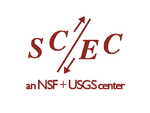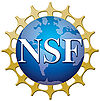Geoinformatics Project
Geoinformatics: Community Computational Platforms for Developing Three-Dimensional Models of Earth Structure
- PI: T. H. Jordan (USC)
- Co-PI: P. Chen (U. Wyoming),
- Co-PI: Y. Cui (SDSC)
- Co-PI: J. Tromp (Princeton)
- Sr Scientist: J. Shaw (Harvard)
- Sr Scientist: K. Olsen (SDSU)
- Sr Scientist: C. Tape (U of Alaska)
- Sr Scientist: P. Maechling (USC)
Summary. Precise information about the structure of the solid Earth comes from seismograms recorded at the surface of a highly heterogeneous lithosphere. Full-3D tomography based on adjoint and scattering-integral methods can assimilate this information into three-dimensional models of elastic and anelastic structure. These methods fully account for the physics of wave excitation, propagation, and interaction by numerically solving the inhomogeneous equations of motion for a heterogeneous anelastic solid. Full-3D tomography using adjoint and scattering-integral methods requires the execution of complex computational procedures that challenge the most advanced high-performance computing (HPC) systems. Current research is petascale; future research will require exascale capabilities.
We propose to establish an interoperable set of community computational platforms—vertically integrated systems of hardware, software, and wetware that will allow a significant community of investigators to employ the techniques of full-3D tomography to refine Earth structures. Two tomographic platforms will be built on highly scalable codes for solving the forward problem: the AWP-ODC 4th-order, staggered-grid, finite-difference code, which has been widely used for regional earthquake simulation and physics-based seismic hazard analysis (development led by K. Olsen), and the SPECFEM3D spectral element code, which is capable of modeling wave propagation through aspherical structures of essentially arbitrary complexity on scales ranging from local to global (development led by J. Tromp). A third platform, based on the Unified Community Velocity Model (UCVM) software developed by the Southern California Earthquake Center (SCEC), will provide a common framework for comparing and synthesizing Earth models and delivering model products to a wide community of geoscientists. These platforms will be deployed at the NCAR-Wyoming Supercomputing Center (NWSC). This proposal will be matched with allocation requests for use of Yellowstone at NWSC, to be submitted to NSF in March, 2012. The development and optimization of codes for Yellowstone and NWSC's next generation many-core hybrid systems will be led by Y. Cui.



